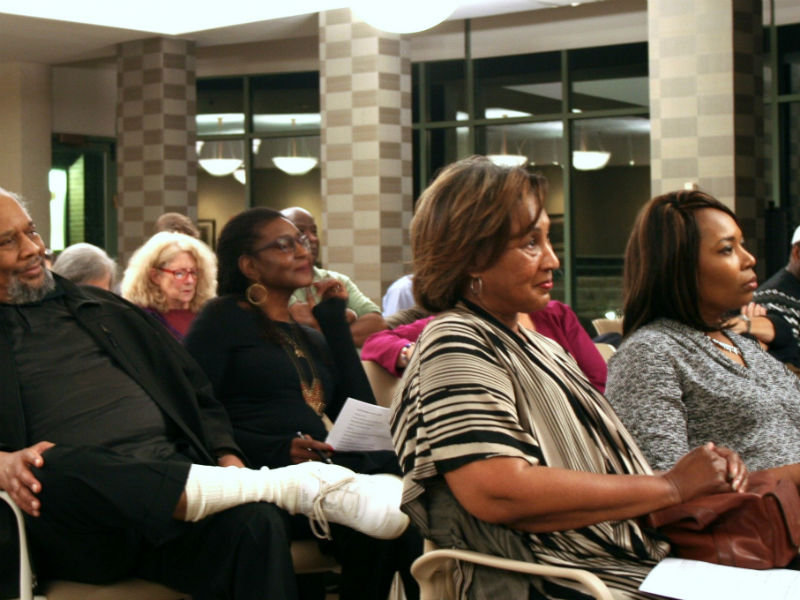When Milwaukee police find themselves in a bad situation – a really bad situation – there's only one way out: and that's to rely on their training to save victims and each other when a scene is too hot for traditional paramedics.
While police are regularly shouldered with the job of neutralizing a threat, the task of tending to the injured while an active shooter looms in the foreground is both extremely stressful and perilous.
But proper training can make such situations at least more familiar.
That's where Tactical EMS Training, or TEMS, comes in. For the last several years, a handful of police officers and EMTs have led a week-long seminar at the Waukesha County Technical College to bring law enforcement up to speed on the latest modalities for applying triage care while the bullets are flying.
At the April course, 28 MPD officers and EMTs studied, in classrooms, the Tactical Emergency Casualty Care guidelines for civilian EMS and law enforcement. The development and implementation of this course is taken straight from the pages of the Department of Defense's requirement to establish mission-specific combat casualty care.
On the final day of the class, they put what they've learned to the test in three ultra-realistic scenarios. I was fortunate enough to join them.
Scenario one: "cult house," with active shooter and an unknown number of wounded
After grilling out for lunch, the tone of officers becomes much more serious as they go through a safety check to make sure their real guns have been replaced by "airsoft" pistols and rifles. The instructors, led by MPD Officer Chad Stiles, literally frisk each and every one of them.
"This training can mean life or death to officers," says Stiles. "We have taken evidence based military medicine concepts and adapted them for the law enforcement setting to treat injuries that can kill an officer or other victim in 3-5 minutes. Even given the fact that we have one of the best EMS systems in the state, and access to a hospital in less then 10 minutes from anywhere in the city, if the officer can't get to that definitive care due to an unsafe scene or prolonged extrication time, they will die."
The group is split up into three teams, and they're given the rules of engagement: "deadly" force is authorized, but officers must be careful not to hurt the "victims" or the "suspects." The victims in this scenario are friends and family of the students. The suspects are fellow officers, and they will get shot with pellets.
At 12:10 p.m., the officers switch their police radios to channel one and pile into three vehicles. They have a general idea of what's about transpire, but they don't know details.
At 12:20 p.m. Stiles and I drive just off campus to a ranch house donated to the college for these kind of exercises. He puts up a "police training" sign in the driveway, then feigning breathlessness, he relays the situation to dispatch: a loud music complaint at a house with previous issues. Suddenly he yells, "Shots are fired! There's a male suspect wearing some type of red hoodie!"
As the teams pour onto the scene, the "cult leader" steps outside and begins firing his gun. The officers leap out of their vehicles and begin to advance upon the house; first from behind trees then across the driveway, guns drawn.
Inside the house, it's a scary scene, and for a moment, I forget that I can walk amongst the action – because, like the instructors, I'm wearing a yellow vest and safety goggles.
It feels like I'm a ghost, actually, taking photos and video with guns pointed in my face. I do my best to stay out of everyone's way.
It's dark, and loud music is blaring. A smoke machine makes the carnage hard to discern, but screaming and moaning victims lie strewn throughout. The police apprehend the suspects – the mock cult leader has already committed suicide – and bring the victims out for triage by 12:45 p.m.
During the debriefing, Stiles notes that this group performed the quickest entry of all his classes, and that's important, because a person can bleed to death in 3-5 minutes. The officers discuss how hard it was to hear each other (in a typical scenario like this, they would've killed the music and turned on the lights, but were instructed not to for training purposes). A student also notes that one of the victims in triage had a gun, and they need to ensure they separate the victims from the suspects. The amateur radio volunteers who coordinated the radio response report that they are impressed with the smoothness of the operation.
Scenario two: officers down at the "fire grounds," call for backup
This situation is more precarious. When we pull up to the fire tower at 1:20 p.m., sirens are already blaring as bleeding "officers" lie on the ground outside their squad cars. We advance upon the tower and quickly notice that we're taking fire from the upper floors. I follow one team onto the second level, where we come upon an injured policeman. As the officers consider how to evacuate him, they realize they're barricaded in.
The next few minutes are tense, and two officers aim their guns at the door, while another calls down for a rope. Eventually, one is tossed up, and two officers make an impromptu pulley to get him down.
The floor is cleared, and we head out of the room and up the stairs, when suddenly, a voice screams, "Bomb! Everybody get the f*ck out!"
A wave of officers come flying past me, and because I feel dumb just standing there, I join them in sprinting down the stairs and out the building to "safety." During the debriefing, the sargeant explains that he found an improvised explosive device on the top floor. Obviously, the participants didn't know this was coming, and it made for an interesting wrinkle in an already scary scene.
Scenario three: school shooting with active shooter and multiple victims
Ripped straight from the headlines, this is the most chilling scenario for me because it feels the most real. At 2:15 p.m., the dispatcher announces that a while male, dressed in black, standing at 5 feet, 8 inches, is shooting up a school.
The three teams assemble at an actual school across from campus and enter from the parking garage. They gather up in a diamond formation, hands on each others' shoulders, so all angles are covered.
It seems like organized chaos as the teams split into two groups to storm the building. They go room to room, finding and treating victims, but also confronting potential armed suspects. What is unexpected is the breakdown in communications as the radios became overloaded in chatter.
"Communications took a header," Sgt. Walter McCollough says during the recap, and he relied on verbal – and very loud – communication to take over. "Shut up now! Pay attention!" he screams, and people do.
As the police neutralize the threats, they then focus on the victims, first bringing them into a safe room for triage, then carrying them back to the parking garage to stabilize them until the Flight For Life helicopter arrives.
Even though it feels sloppy – and what disaster isn't – Stiles says he is pleased with what he saw. "Medically, it was good, all three," he says.
Adds Stiles, "The officers that took this course were able to treat, tactically extricate, triage and prepare for transport and turnover to EMS over 20 critically injured patients in three major mass casualty scenarios all in a hostile environments, and arrest or stop the treat of all the all bad guys in a matter of minutes.
"These officers, who represent many of the districts and units all over the city – many of which have never worked together before this week – were able come together and work as a team to save lives. The scenarios were designed to test the limits of the their past training as they implemented their new training they learned this week ... They are heroes who really do risk their lives everyday to keep the citizens of Milwaukee safe."
And for Officer Christopher Martin, who used personal days to attend this workshop, the seminar was helpful. An officer on the Major Incident Response team at District One since 2004, he says this kind of training saves lives, and it could even save his own.
"You always want to better yourself," he says.
One of the trainers, Chris Cook, of the Walworth County Sherriff's Office SWAT Team, would know. While serving in Iraq with the Army National Guard, his vehicle was struck with an IED in 2004 and he had to apply his own tourniquet, barely saving the amputation of his left leg.
"Traditional EMS general comes to a scene when it's deemed safe, and these guys are already working in an unsafe environment.
"We're utilizing military medical skills," says. "Prior to doing any medical care, we're asking the officers to stop the threat, rescue themselves, injured officers or civilian, and then do these medical skills."
Before the first scenario I asked Cook if the officers took this seriously. At the end, I know for sure they did.
Says Cook, "We try to make it as real as possible, but the different scenarios, there's an adrenaline dump going on for sure.
"Statistics show that survivability is increased when care is rendered at that point of wounding. This is akin to a combat zone; a bullet does not know geography. We're just giving these guys an opportunity to save their life."
Andy is the president, publisher and founder of OnMilwaukee. He returned to Milwaukee in 1996 after living on the East Coast for nine years, where he wrote for The Dallas Morning News Washington Bureau and worked in the White House Office of Communications. He was also Associate Editor of The GW Hatchet, his college newspaper at The George Washington University.
Before launching OnMilwaukee.com in 1998 at age 23, he worked in public relations for two Milwaukee firms, most of the time daydreaming about starting his own publication.
Hobbies include running when he finds the time, fixing the rust on his '75 MGB, mowing the lawn at his cottage in the Northwoods, and making an annual pilgrimage to Phoenix for Brewers Spring Training.







